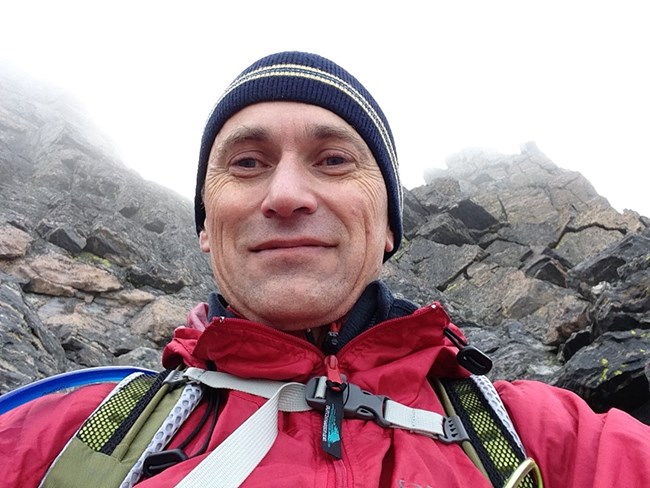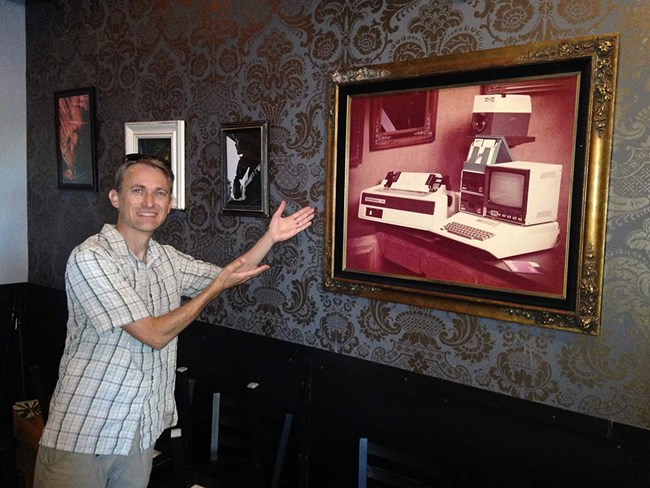Last updated: October 1, 2021
Article
Data Manager Profile: Simon Kingston

NPS / Simon Kingston
Finding the “sweet spot” for data management: one part computer nerd, one part passion for nature
"As a kid, I remember when my dad first brought home a PC junior computer and I was immediately fascinated. I'd write little programs to solve puzzles, and my brother would run them. I'd always been interested in math and science in school, too.
"In high school I took some programming courses. I could see the power of computers, so I started college at Cal Berkeley as an electrical engineering and computer science major. But it didn't feel like the right fit. I was flipping through the course catalog, trying to figure out what to do, and found forestry. I immediately thought about childhood summer vacations, and my parents dragging a tent trailer around. We lived in Edmonton, Canada, and would summer in Banff and Jasper National Parks in the Canadian Rockies. I have such fond memories of the spectacular scenery. Being outside and working with trees— I liked that idea!
"So I switched majors over to forestry and loved it. These were the people I wanted to work with: outdoorsy science folks, people who just ‘got’ nature. But I also maintained a technical bent, where I liked organizing things and using computers to help achieve an end. I think that that skillset really paid off. The intersection of nature and computer nerd is the sweet spot for data management with the national parks. It's a fun job for folks who have passion for science, but also get the technical stuff and are able to create solutions that support scientists."
Problem-solving for a young and growing Inventory & Monitoring Program
"I've been working for the Inventory and Monitoring Division for almost 20 years. In 2000, I started as a partner research associate through Colorado State University. I was brought on to help out with the NPSpecies application, which is all about tracking the occurrence of organisms in parks.
"Inventory and Monitoring was pretty young at that point. Things had been moving along for five or six years, but it really hadn't grown and blossomed yet. Now Inventory & Monitoring seems huge. We've got 32 networks that are fully up and running, with hundreds of staff doing great work.
"Helping the team solve a database problem during my interview turned out to be one of the things that got me the job. That first position was really about setting up quality control checks, automation and a tracking system to manage the huge inflow of data into NPSpecies and make peoples’ jobs easier. In the more recent years, I've been in a more central support role helping networks with the practical implementation of data standards and systems.
"The basis of excellent science is excellent data, and as the Inventory & Monitoring Program, we collect a lot of data. We need to ensure the longevity of that data. Without that solid defensible data foundation, anything else you put on top of it—reports, analyses, visualizations, you name it—won’t hold up."

NPS
The future of public data
"I feel strongly about getting data out to the public. It used to be that the reports were gold, and nobody from the public would necessarily be able to get their hands on the raw data. That has shifted 180 degrees: it's a data-driven society now, and people want to see the raw data.
"We started a task force of data managers and science staff from all the networks and brought them together to plan ahead and decide how to manage our data into the future. I led a bunch of working groups, which was a stretch for me because I'm an introverted guy and having to run meetings and lead people was a challenge. But I really believe in what we are trying to do. We’ve got a long way to go, but we’re moving ahead.
"There’s a big cultural shift that has to occur. If I look to a shiny future, it’s university professors teaching courses using Inventory and Monitoring datasets, and networks publishing high quality datasets on a regular basis that are open, machine-readable, and fully documented to support everybody being able to use them. We need to be at a point where somebody else can grab the data, do some number crunching, come up with interesting questions, and either agree with or challenge our conclusions. I think that's exciting and healthy. This is an opportunity to get other eyes on this data, and that's a good thing for all of us."
Find Simon in the parks, even outside of work
"For our vacations, we go to national parks. I've been passionate about parks before I became an employee. I found Banff National Park in Canada when I was a kid, and that hooked me on national parks for life.
"I am fortunate to be an hour to an hour-and-a-half from trailheads in Rocky Mountain National Park, so when I have a day off I go hiking or trail running. While I'm on the trail, I stop and take pictures of bugs and flowers and post them to iNaturalist. (iNaturalist is a tool for uploading photo observations of nature wherever you are to an international community of naturalists)
"I run pretty much every day, which helps with my sanity. It's a good way to let your mind wander instead of doing intense data management stuff for a bit, and give yourself space to come up with answers to questions."
How the role of Data Manager fits in to the National Park Service ecosystem
"One of the highlights of my career was helping to bring iNaturalist to the parks for the purpose of doing bioblitzes. iNaturalist to me is a perfect example of what clicks with a lot of data managers: it's about a passion for nature, but also about using cool technical tools and gadgets to document that passion for nature. If you're interested in that kind of thing, where you're a list maker and want to know the names of things and keep track of them, data management with the parks might be for you.
"I'm not an expert programmer and I'm not an expert scientist. But I have some expertise in both. And I think that's really where the value of data management is. Most of our data management staff come from a science background, ecology or biology, and they recognize the value of data, or like being on the computer and have the technical and organizational expertise: knowing databases and how they work, geospatial representation of data, organization of systems, processes, and checklists. Something that is not necessarily as recognized, but needs to be, is communication skills, and that shows up in every profession. There’s a need for communicating the story of the data, and how it is the foundation for an analysis or report.
"I try to help people think about how our mission with the National Park Service, to preserve unimpaired the resources for future generations, steps down. There’s a chain from the park staff making decisions about managing resources that links all the way back to the data collected in the field by science staff doing the monitoring. The data are managed and curated in a fabulous database system and published in open, machine-readable datasets—for this and future generations—by the data managers."
2021 UPDATE: Simon is no longer an Inventory & Monitoring Program Data Manager. He's now a Data Ranger with the National Park Service's Environmental Quality Division.
